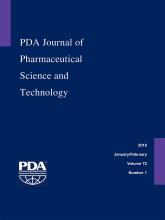Abstract
For many years, glass has been the default material for parenteral packaging, but the development of advanced plastics such as cyclic olefin polymers and the rapidly increasing importance of biologic drugs have provided new choices, as well as more stringent performance requirements. In particular, many biologics must be stored at non-neutral pH, where glass is susceptible to hydrolysis, metal extraction, and delamination. Plastic containers are not susceptible to these problems, but suffer from higher gas permeability and a propensity for sterilization-induced radical generation, heightening the risk of oxidative damage to sensitive drugs. This study evaluates the properties of a hybrid material, SiOPlas™, in which an ultrathin multilayer coating is applied to the interior of cyclic olefin polymer containers via plasma-enhanced chemical vapor deposition. Our results show that the coating decreases oxygen permeation through the vial walls 33-fold compared to uncoated cyclic olefin polymers, which should allow for improved control of oxygen levels in sensitive formulations. We also measured degradation of two biologic drugs that are known to be sensitive to oxidation, teriparatide and erythropoietin, in gamma and electron beam sterilized SiOPlas™, glass, and uncoated cyclic olefin polymer vials. In both cases, solutions stored in SiOPlas™ vials did not show elevated susceptibility to oxidation compared to either glass or unsterilized controls. Taken together, these results suggest that hybrid materials such as SiOPlas™ are attractive choices for storing high-value biologic drugs.
LAY ABSTRACT: One of the most important functions of parenteral drug containers is safeguarding their contents from damage, either chemical or physical. Glass has been the container material of choice for many years, but concerns over breakage and vulnerability to chemical attack at non-neutral pH have spurred the rise of advanced plastics as alternatives. Plastics solve many problems associated with glass but introduce several of their own, including increased gas permeation and generation of oxidizing radicals during sterilization. In this article, we evaluate SiOPlas™, a hybrid material consisting of plastic with a thin multilayer coating applied to the interior, for its ability to overcome these two problems. We find that SiOPlas™ is much less permeable to oxygen than uncoated plastic, and that two biologic drugs stored in gamma and electron beam sterilized SiOPlas™ vials do not display elevated levels of oxidation compared to either glass or unsterilized vials. This suggests that hybrid materials such as SiOPlas™ can exhibit the best qualities of both glass and plastic, making them attractive materials for storing high-value parenteral drugs.
- © PDA, Inc. 2018
PDA members receive access to all articles published in the current year and previous volume year. Institutional subscribers received access to all content. Log in below to receive access to this article if you are either of these.
If you are neither or you are a PDA member trying to access an article outside of your membership license, then you must purchase access to this article (below). If you do not have a username or password for JPST, you will be required to create an account prior to purchasing.
Full issue PDFs are for PDA members only.
Note to pda.org users
The PDA and PDA bookstore websites (www.pda.org and www.pda.org/bookstore) are separate websites from the PDA JPST website. When you first join PDA, your initial UserID and Password are sent to HighWirePress to create your PDA JPST account. Subsequent UserrID and Password changes required at the PDA websites will not pass on to PDA JPST and vice versa. If you forget your PDA JPST UserID and/or Password, you can request help to retrieve UserID and reset Password below.






